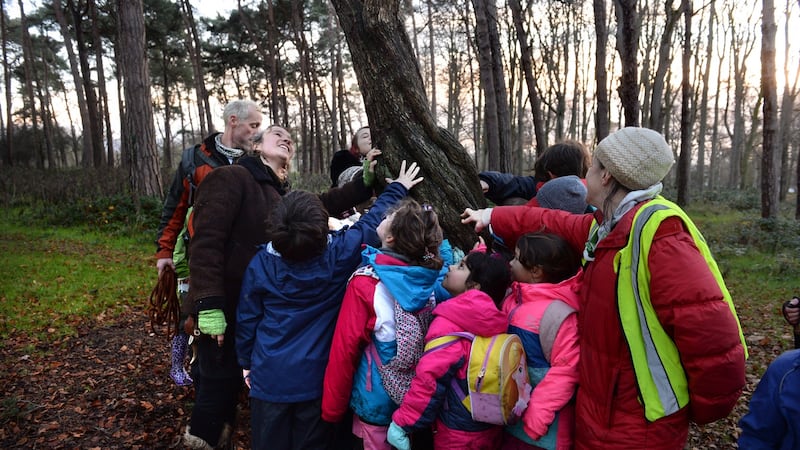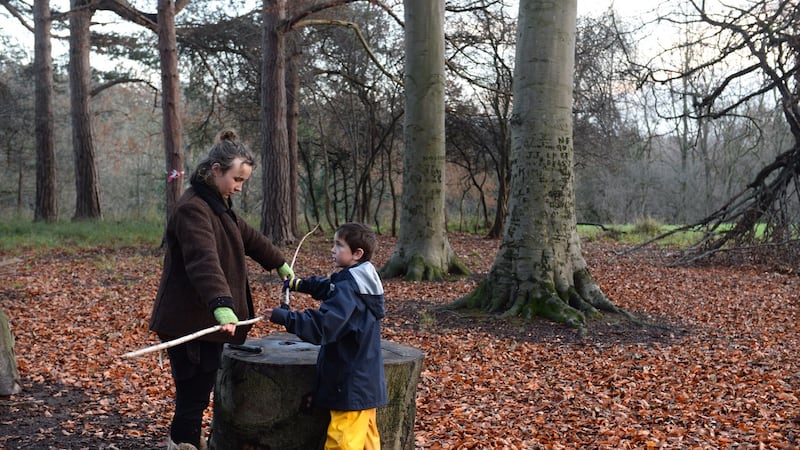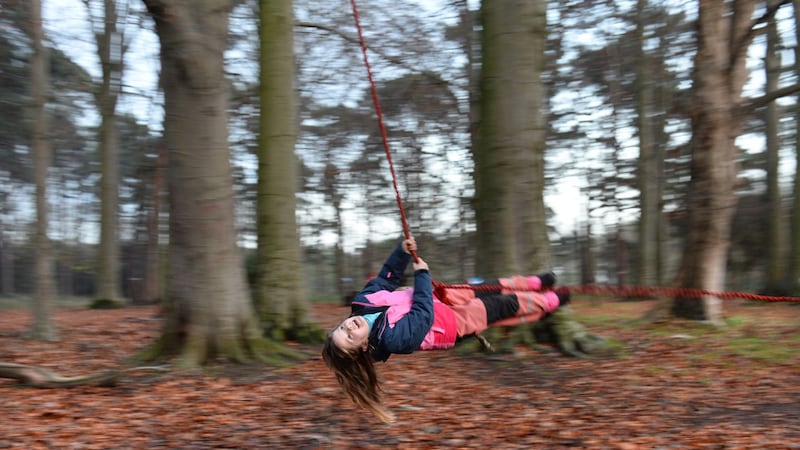Two very handsome little woods, one mature Scots pine, the other equally venerable beech, stand side by side above the southwestern slopes of the furry glen in the Phoenix Park. I thought I knew them pretty well, but I have to admit I had never encountered their guardian tree until I was shown it by the children of the Phoenix Forest School. What we see in nature is, all too often, determined by what we are looking for.
This guardian tree is a gnarled hawthorn, dwarfed by the high beech canopy. But it is nonetheless quite remarkable, its ancient trunk twisting sinuously around itself repeatedly. You just might take it for a great grey snake in the fading winter light.
Twenty children, from several schools, and their adult forest guides are gathered tightly around this trunk, hugging each other as much as the tree. They are “asking its permission” to stay in the woodlands, and singing a song of praise to its bright red berries, high above them, the “haw lanterns” of Heaney’s poem.

Okay, okay, I know, I know. Tree-hugging has had a bad rap. Probably rightly so, in many cases. But what followed was one of the most heart-warming gatherings I have witnessed in a long time, and we do need our hearts warmed in this wintry time of environmental discontents.
School time
The school had actually started half an hour earlier, when Dara McCullough (8) arrived on the outer edge of the woods with his mother, Emma Costello. He runs off at once to the staging post, set up with ropes so the kids can climb a muddy slope. Unprompted, he begins to lay dead branches against one of the ropes, making an impromptu shelter. It is 3pm and the sky is clear, but the morning had seen torrential rain. But that would not have stopped the forest school. Only exceptionally high winds cause cancellations.
Costello watches Dara moving branches for a few moments before heading off. “He can never wait to get outside,” she says happily. “Even when he was a baby he would crawl into the garden, turning over rocks to find creepy crawlies. He still has a pet millipede.”
More and more kids, aged from six to 12, are now gathering at the staging post. They are playing, together or individually, under the watchful eyes of five instructors, whose interventions are minimal. “This is child-led learning,” one of them says. At this stage, much of it is pure play, but perhaps the sharp line we often draw between playing and learning is artificial. “Look, my gloves are covered in muck,” one little girl says with glee, having obviously learned here that clean dirt is no bad thing.
Now it's time to start our trek into the woods, led by the school's founder, Lucy O'Hagan, who teaches traditional nature-related skills to both adults and children through her own organisation Wild Awake (wildawake.ie).
She has the happy knack of unselfconsciously directing activities through song and story, while leaving space for self-starters to do their own thing. The afternoon is already reminding me of the best bits of being a boy scout, without either the macho or relentlessly jolly-hockey-sticks adult attitudes that sometimes soured those experiences.
Clearing
Once the permission of the guardian tree has been granted, we move on deeper into the woods, till we find a clearing. A circle of big logs provides seats around a fireplace, created out of a large hub cap to securely contain the fire. A lot of the tools used in the school are taken directly from nature, like sticks and stones, but industrial age implements also have their place here.

O’Hagan outlines the afternoon’s activities: the children can make deerskin pouches to hold kindling, or create wooden reindeer using whatever is lying around. (Right on cue, two of the park’s fallow deer had appeared, and disappeared, as we approached the fireplace.)
Or the kids can play on swings and climb trees. They can also make bows and arrows, which proved to be the most popular choice. Or they can simply amuse themselves. One girl quietly builds a shelter in the bole of a tree away from the main action. “There’s so much going on, I need my own space to think about it all,” she explains.
Curiously, none of them displays much interest in a fox skin – courtesy of roadkill – laid out for tanning, though one intrepid girl likes examining its fur with a hand lens. Maybe tanning will be the focus next week, maybe not; the children make their own choices.
One enterprise that is always popular is fire-lighting, done without matches. A little ball of bulrush fluff from a nearby pond lies in the centre of bark and twig kindling. With great patience and rapt attention, a little boy rubs two fire steels together, over several minutes. Sparks fly, from time to time, but they don’t ignite the fuel. O’Hagan quietly shows him how to unspool the fluff to make it more flammable, and suddenly it leaps into flame. The twigs follow, and soon there is a warm blaze in the centre of the log circle.
Creative play
All around, there are energetic foci of creation, and bursts of play. Under canvas tarps – there are several, though the weather remains clement – three girls punch holes in little circles of deerskin. They painstaking thread twine through them to make pouches. Out in the open, children are using the sharp edges of stones to strip light ash branches, for arrows. But knives are needed to make notches for the bow strings on thicker lengths of wood.
Unobtrusively but obviously effectively, O’Hagan and her colleagues remind the children to respect the dangers that come with sharp instruments, fire or with climbing trees. Over nearly three hours, I never hear a voice raised, except in laughter. And I never see anyone getting hurt.

Finally, with darkness now blanketing us, wolf howls are the signal for everyone to gather round the flickering fire-light for hot apple juice. A "speaking stick" is passed around, so that each child can tell The Irish Times what they like about forest school.
Almost every child speaks, and the attention with which they listen to each other is striking. So are their answers. “You learn what you can make with nature.” “You can make whatever you want out of sticks and stones and mud, and sometimes you are even allowed to light fires.” “It’s fun, fun, and more fun.” “It’s about nature, it’s about the world as it should be.”
Holding that last thought, we gather up our stuff, and all grasp a single rope so that no one gets lost leaving the forest. That rope idea, like so much on this afternoon, came spontaneously from the mind of one of the children.
‘To encourage and inspire’
The Phoenix Forest School is an after-school programme that runs during term-time. It costs €20 per child per session. There also camps during holidays at €35 per day from 10am to 3pm.
The school is part of the Irish Forest School Association, with 20 schools scattered across nine counties. There is a sister association in Northern Ireland.
Courses for adults, teaching skills ranging from mushroom foraging and animal tracking to more hardcore survival skills, are also available.
The underlying philosophy is straightforward: “to encourage and inspire individuals of any age through positive outdoor experiences.”
For further information
[ wildawake.ie/classes/#tab1 ]
[ irishforestschoolassociation.ie/whatisforestschool/ ]
[ nifsa.org.uk/ ]












